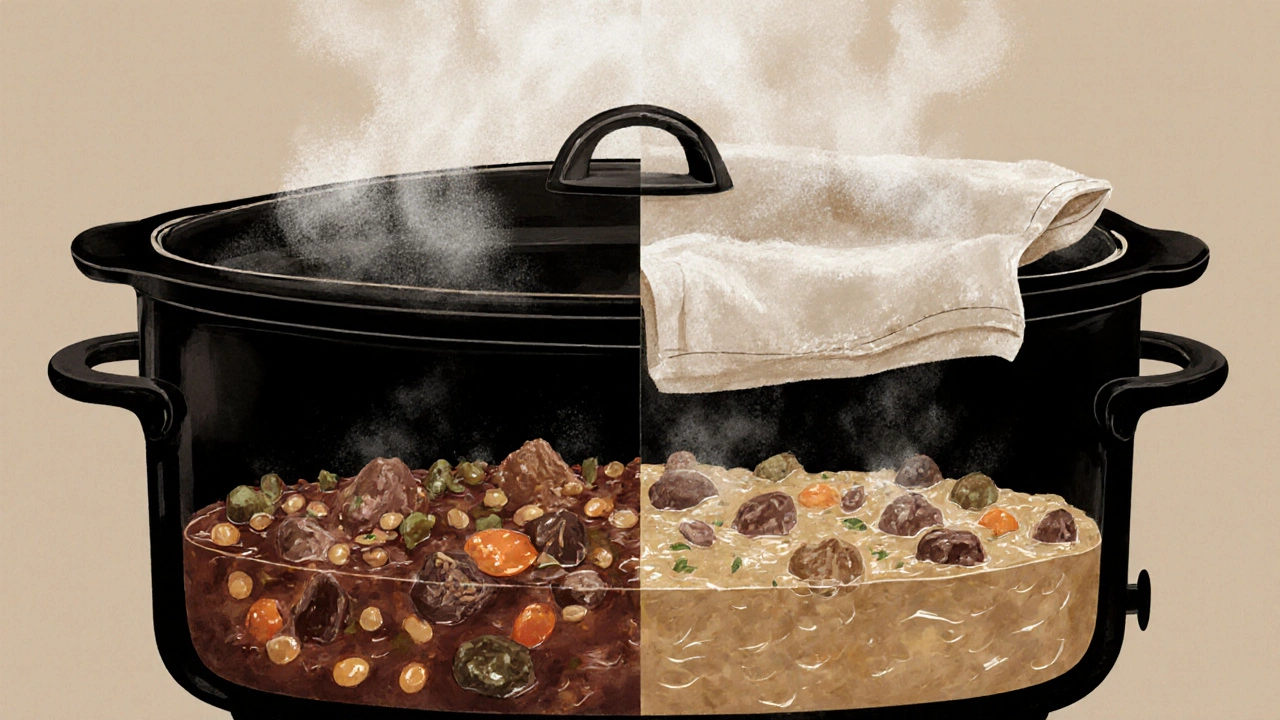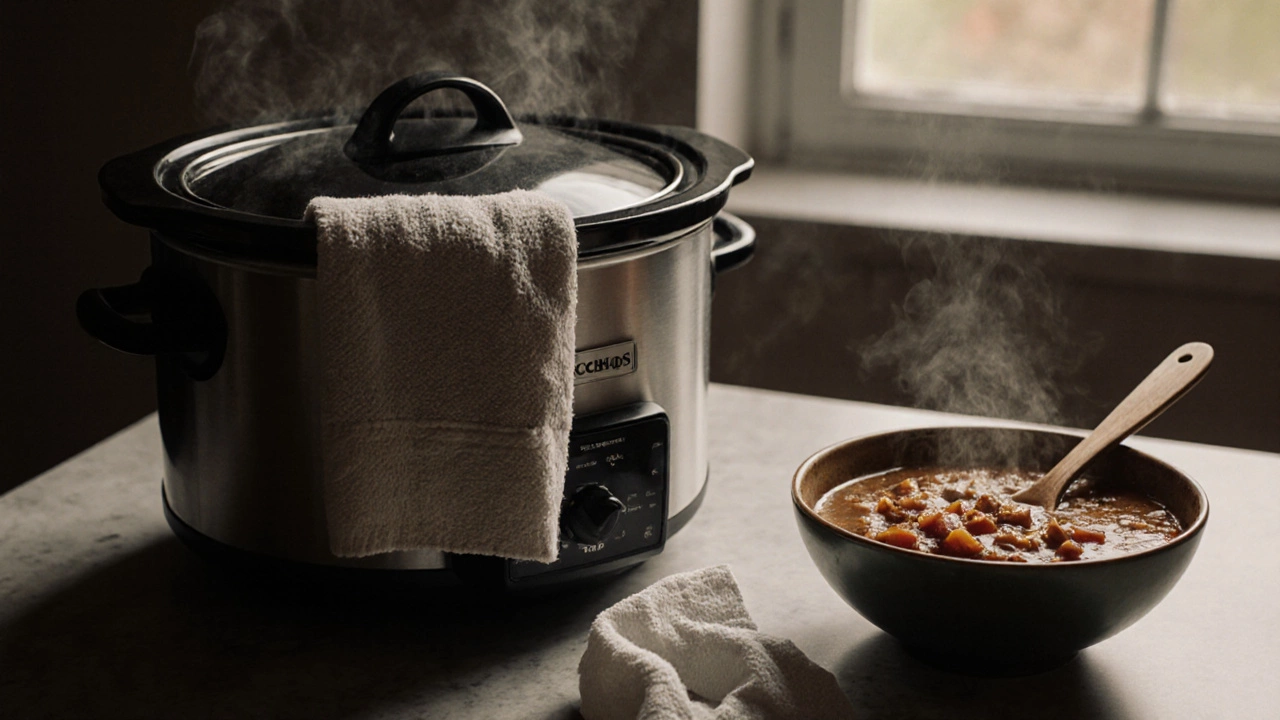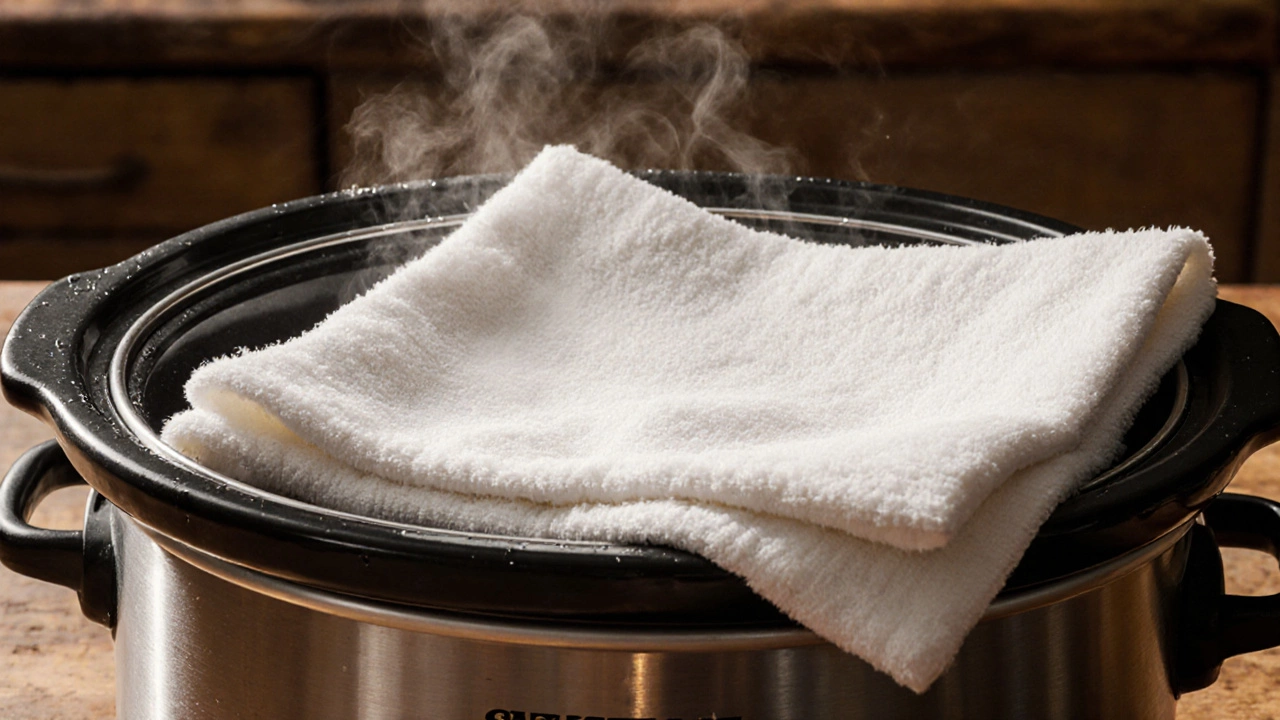Slow Cooker Moisture Calculator
Use this calculator to estimate excess moisture in your slow cooker dishes and how the tea towel trick can reduce it.
Based on the article: A 6-quart pot can collect over 1 cup of extra liquid after 10 hours of cooking.
Ever opened your slow cooker after eight hours only to find your stew watery, your pulled pork soggy, or your sauce more like soup? You’re not alone. Many home cooks blame the appliance-until they learn the tea towel trick.
What Exactly Is the Tea Towel Trick?
The tea towel trick is a simple, low-tech way to reduce excess moisture in your slow cooker. You place a clean, dry tea towel (or kitchen towel) between the lid and the pot, then put the lid on top. The towel acts like a sponge, soaking up steam before it can condense and drip back into your food. It’s not magic. It’s physics. Slow cookers work by trapping heat and steam. That’s great for tenderizing tough cuts of meat, but terrible if you want thick, rich sauces or crispy edges. Without intervention, that steam turns into water, pooling at the bottom and diluting flavors. The tea towel interrupts that cycle.Why Does Moisture Ruin Slow Cooker Meals?
Think about how your slow cooker works. The lid seals tightly. Heat rises, hits the lid, cools, and drips back down. Over hours, that adds up. A 6-quart pot can collect over a cup of extra liquid by the end of a 10-hour cook. That’s not just water-it’s flavor lost. You’ll see it in dishes like:- Beef stew that tastes bland instead of deep and savory
- Pulled pork that’s tender but swimming in juice
- Chili that never thickens, no matter how long it simmers
- Chicken curry with a watery sauce that won’t coat the spoon
How to Use the Tea Towel Trick
It’s dead simple. Here’s how to do it right:- Use a clean, dry, 100% cotton tea towel. No linty towels, no synthetics. Cotton absorbs best and won’t shed fibers.
- Fold it into a square about 6x6 inches. Large enough to cover the entire surface of the pot’s rim, but small enough to fit under the lid.
- Place the towel evenly over the top of the slow cooker insert, right where the lid sits.
- Put the lid on top, pressing down gently so the towel is snug but not crushed.
- Let it cook as normal. No need to check or adjust.
What Kind of Towel Works Best?
Not all towels are created equal. Here’s what to look for:- Material: 100% cotton. Polyester or blends won’t absorb well and can melt or smell funny when hot.
- Weight: Medium-thick. Too thin (like a dishcloth) and it won’t hold enough moisture. Too thick (like a bath towel) and it won’t fit under the lid.
- Color: White or light. Dark dyes can bleed into the steam, especially if the towel’s new.
- Condition: Clean, no fabric softener. Softener leaves a residue that repels water, making the towel less effective.

When Should You Use It? (And When Not To)
This trick isn’t for every recipe. Use it when you want:- Thicker sauces and gravies
- More concentrated flavor
- Less watery results
- Better texture in meats (less sogginess)
- Recipes that need added liquid (like soups or broths)
- Dishes with lots of vegetables that release water (like zucchini or tomatoes)-they need the moisture
- Recipes that call for a splash of wine, broth, or water as a key ingredient
Real Results: Before and After
I tested this with a classic beef and barley stew. Same pot, same ingredients, same time. One batch with the towel, one without. Without the towel: The broth was clear, thin, and tasted flat. The beef fell apart, but the whole dish felt watery. With the towel: The sauce clung to the barley. The beef had a richer, deeper flavor. The vegetables held their shape better. The final volume of liquid was reduced by nearly 40%. I didn’t add a drop of thickener. No flour, no cornstarch. Just a towel.Alternatives to the Tea Towel Trick
If you don’t have a tea towel, or you’re nervous about using fabric near heat, here are other ways to control moisture:- Leave the lid slightly ajar: Prop it open with a wooden spoon. Lets steam escape. But you lose heat, so cooking time increases.
- Remove the lid for the last hour: Effective, but you have to remember to do it. Also risks overcooking if left too long.
- Use a slow cooker with a vented lid: Some newer models have built-in steam vents. These are great-but not common.
- Thicken at the end: Mix cornstarch with cold water and stir in during the last 30 minutes. Works, but adds carbs and changes texture.

Common Mistakes to Avoid
Even simple tricks can go wrong. Here’s what not to do:- Using a damp towel. It won’t absorb steam-it’ll just add more water.
- Using a towel with synthetic fibers. Can melt or release chemicals.
- Putting the towel inside the pot. It’s meant to go under the lid, not in the food.
- Leaving it on too long after cooking. Remove it as soon as you turn off the cooker. Damp towels can harbor bacteria if left in a warm pot.
Why This Trick Works So Well in Australia
In places like Melbourne, where winters are damp and chilly, slow cookers are a staple. But our kitchens aren’t always climate-controlled. Humidity in the air can make condensation worse. The tea towel trick cuts through that. Plus, many Australian households use older slow cookers-models without adjustable settings or vents. The towel trick gives you control without upgrading your gear.Final Thoughts: A Small Change, Big Impact
The tea towel trick isn’t a fancy gadget. It doesn’t cost money. You probably already have what you need. But it transforms your slow cooker from a “set-it-and-forget-it” appliance into a precision tool. No more watery curries. No more bland stews. Just richer, deeper, more satisfying meals with less effort. It’s the kind of hack that makes you wonder why no one told you sooner.Can I use a paper towel instead of a tea towel?
No. Paper towels can disintegrate in high heat and steam, leaving bits in your food. They also don’t absorb moisture as effectively as cotton. Stick with a clean, dry 100% cotton tea towel.
Will the tea towel catch fire?
Not if you use it correctly. The towel sits under the lid, not touching the heating element. Slow cookers operate at temperatures far below the ignition point of cotton (around 400°F). The towel gets hot and damp, but not hot enough to burn. Just make sure it’s not frayed or near the edge where it could slip into the pot.
How long should I cook with the tea towel?
Use it for the entire cooking time. The longer you cook, the more steam builds up-and the more the towel helps. There’s no need to remove it halfway through. Just leave it on from start to finish.
Does the tea towel trick work on all slow cooker sizes?
Yes. It works on 2-quart, 6-quart, and even 8-quart models. Just adjust the size of the towel. For smaller pots, fold it smaller. For larger ones, use two towels side by side. The key is covering the rim evenly so steam can’t escape around the edges.
Can I use this trick with a glass lid?
Absolutely. Glass lids work just fine. The towel goes between the lid and the pot’s rim, so the material of the lid doesn’t matter. Just make sure the towel is flat and doesn’t block the lid from sealing properly.

